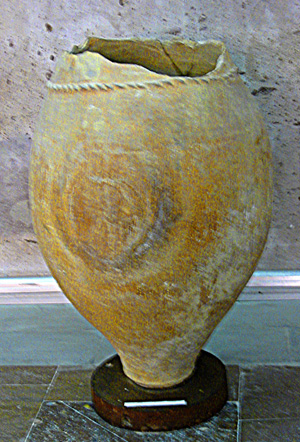Armenian wine
Overview of Armenian wine
Armenian wine refers to the wine produced in the country of Armenia, a region with a rich history of viticulture and winemaking that dates back thousands of years. Armenia is considered one of the oldest wine-producing regions in the world, with archaeological evidence suggesting that wine production in the area began as early as 4100 BC.
History[edit | edit source]
The history of Armenian wine is deeply intertwined with the history of the region itself. The discovery of the Areni-1 cave complex in 2007 revealed the world's oldest known winery, dating back to around 4100 BC. This site included a wine press, fermentation vats, and storage jars, indicating a sophisticated level of winemaking technology.
During the Urartu period, wine production was a significant part of the economy, as evidenced by the numerous wine storage vessels found in archaeological sites. The Urartian civilization, which thrived in the Armenian Highlands, was known for its advanced agricultural techniques, including viticulture.
Viticulture[edit | edit source]
Armenia's diverse climate and topography provide ideal conditions for viticulture. The country is home to a variety of indigenous grape species, such as Areni, which is particularly well-suited to the high-altitude vineyards of the Vayots Dzor Province.
The volcanic soil and the unique microclimates of the region contribute to the distinctive flavors and characteristics of Armenian wines. Modern Armenian winemakers are increasingly focusing on reviving traditional grape varieties and winemaking techniques, while also incorporating modern technology to improve quality.
Cultural Significance[edit | edit source]
Wine holds a significant place in Armenian culture and tradition. It is often associated with religious ceremonies and celebrations. The annual grape blessing ceremony, known as "Khaghogh Orhnek", is a testament to the cultural and spiritual importance of wine in Armenian society.
Armenian wine is also celebrated in literature and art, with numerous references found in ancient texts and inscriptions. The Armenian Apostolic Church has played a crucial role in preserving the winemaking tradition through the centuries.
Modern Industry[edit | edit source]
In recent years, the Armenian wine industry has experienced a renaissance, with a growing number of wineries producing high-quality wines for both domestic and international markets. The industry is supported by government initiatives and investments aimed at promoting Armenian wine globally.
Armenian wines have gained recognition at international wine competitions, and the country is becoming an increasingly popular destination for wine tourism. The combination of ancient traditions and modern innovation is positioning Armenia as a notable player in the global wine industry.
Related pages[edit | edit source]
See also[edit | edit source]
Search WikiMD
Ad.Tired of being Overweight? Try W8MD's physician weight loss program.
Semaglutide (Ozempic / Wegovy and Tirzepatide (Mounjaro / Zepbound) available.
Advertise on WikiMD
|
WikiMD's Wellness Encyclopedia |
| Let Food Be Thy Medicine Medicine Thy Food - Hippocrates |
Translate this page: - East Asian
中文,
日本,
한국어,
South Asian
हिन्दी,
தமிழ்,
తెలుగు,
Urdu,
ಕನ್ನಡ,
Southeast Asian
Indonesian,
Vietnamese,
Thai,
မြန်မာဘာသာ,
বাংলা
European
español,
Deutsch,
français,
Greek,
português do Brasil,
polski,
română,
русский,
Nederlands,
norsk,
svenska,
suomi,
Italian
Middle Eastern & African
عربى,
Turkish,
Persian,
Hebrew,
Afrikaans,
isiZulu,
Kiswahili,
Other
Bulgarian,
Hungarian,
Czech,
Swedish,
മലയാളം,
मराठी,
ਪੰਜਾਬੀ,
ગુજરાતી,
Portuguese,
Ukrainian
Medical Disclaimer: WikiMD is not a substitute for professional medical advice. The information on WikiMD is provided as an information resource only, may be incorrect, outdated or misleading, and is not to be used or relied on for any diagnostic or treatment purposes. Please consult your health care provider before making any healthcare decisions or for guidance about a specific medical condition. WikiMD expressly disclaims responsibility, and shall have no liability, for any damages, loss, injury, or liability whatsoever suffered as a result of your reliance on the information contained in this site. By visiting this site you agree to the foregoing terms and conditions, which may from time to time be changed or supplemented by WikiMD. If you do not agree to the foregoing terms and conditions, you should not enter or use this site. See full disclaimer.
Credits:Most images are courtesy of Wikimedia commons, and templates, categories Wikipedia, licensed under CC BY SA or similar.
Contributors: Prab R. Tumpati, MD






